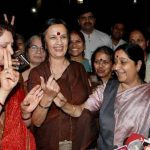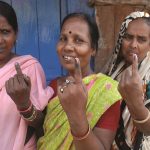- Amy Clair
Writing for The Conversation, Amy Clair and Amanda Hughes explain their findings on the link between people’s housing situation and levels in their blood of C-reactive protein (CRP), a marker associated with stress and infection.

ISER researchers discuss their work in these blog posts.

Writing for The Conversation, Amy Clair and Amanda Hughes explain their findings on the link between people’s housing situation and levels in their blood of C-reactive protein (CRP), a marker associated with stress and infection.

In an opinion piece for the Hindustan Times, Sonia Bhalotra explains how her research with co-authors T. Baskaran, B. Min, Y. Uppal demonstrates that raising the share of women in India’s state legislative assemblies is likely to lead to higher economic growth.

There has been a phenomenal global increase in the proportion of women in politics in the last two decades, but there is no evidence of how this influences economic performance. In a blog for the International Growth Centre, Professor Sonia Bhalotra and co-authors investigate this using data on competitive elections to India’s state legislative assemblies.

Dr Amy Clair has been looking at the impact of insecurity at home on our health and wellbeing.

In principle, leaders can facilitate group coordination towards a common goal but in diverse societies, their effectiveness may depend upon their social identity, and how citizens react to leader identity. Sonia Bhalotra and co-authors Irma Clots-Figueras (Madrid), Lakshmi Iyer (Notre Dame) and Joseph Vecci (Gothenburg) investigate in a blog for Ideas for India.

A new study by MiSoC Co-Director Nicola Barban, with Melinda Mills and Felix Tropf of the University of Oxford, allows the inclusion of a genetic variable or predictor of reproductive behaviour in social science research for the first time.

In an article for the New Statesman, Dr Angus Holford explores in detail what students think of how university fees could be administered in a reformed system where the overall student contribution and taxpayer contribution stayed the same.

Gold is a central component of dowries in India. Writing about her new research in The Conversation, Professor Sonia Bhalotra finds that when the cost of gold rises, so does the death rate of baby girls in the first month of life.

In a new blog for the Conversation, Professor Meena Kumari and Research Associate Amanda Hughes investigate how socioeconomic disadvantage and other environmental factors can affect our biology and life expectancy.

Iva Tasseva looks at why ISER’s tax-benefit microsimulation model EUROMOD is essential for analysing the morning-after effects of tax and benefit reforms, and how new studies using the model have tested out the controversial and increasingly politically fascinating idea of a Basic Income.

In a blog for Global Dev, MiSoC’s Professor Sonia Bhalotra together with Atheendar Venkataramani (Perelman School of Medicine) and Selma Walther (applied microeconomist) investigate whether public investments in reducing child mortality may encourage women into greater economic activity.

Professor Peter Lynn describes how ISER has pioneered a new approach to sample retention which promises to improve the value for money of longitudinal surveys.